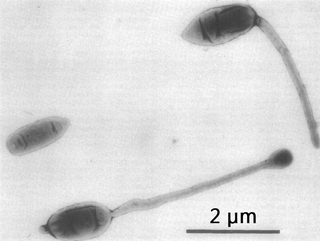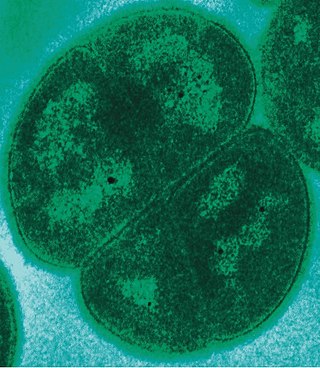The Aquificota phylum is a diverse collection of bacteria that live in harsh environmental settings. The name Aquificota was given to this phylum based on an early genus identified within this group, Aquifex, which is able to produce water by oxidizing hydrogen. They have been found in springs, pools, and oceans. They are autotrophs, and are the primary carbon fixers in their environments. These bacteria are Gram-negative, non-spore-forming rods. They are true bacteria as opposed to the other inhabitants of extreme environments, the Archaea.

The Hyphomicrobiaceae are a family of bacteria. Among others, they include Rhodomicrobium, a genus of purple bacteria.

Deinococcus is in the monotypic family Deinococcaceae, and one genus of three in the order Deinococcales of the bacterial phylum Deinococcota highly resistant to environmental hazards. These bacteria have thick cell walls that give them Gram-positive stains, but they include a second membrane and so are closer in structure to Gram-negative bacteria. Deinococcus survive when their DNA is exposed to high doses of gamma and UV radiation. Whereas other bacteria change their structure in the presence of radiation, such as by forming endospores, Deinococcus tolerate it without changing their cellular form and do not retreat into a hardened structure. They are also characterized by the presence of the carotenoid pigment deinoxanthin that give them their pink color. They are usually isolated according to these two criteria. In August 2020, scientists reported that bacteria from Earth, particularly Deinococcus bacteria, were found to survive for three years in outer space, based on studies conducted on the International Space Station. These findings support the notion of panspermia, the hypothesis that life exists throughout the Universe, distributed in various ways, including space dust, meteoroids, asteroids, comets, planetoids or contaminated spacecraft.
The Negativicutes are a class of bacteria in the phylum Bacillota, whose members have a peculiar cell wall with a lipopolysaccharide outer membrane which stains gram-negative, unlike most other members of the Bacillota. Although several neighbouring Clostridia species also stain gram-negative, the proteins responsible for the unusual diderm structure of the Negativicutes may have actually been laterally acquired from Pseudomonadota. Additional research is required to confirm the origin of the diderm cell envelope in the Negativicutes.
Agromyces is a genus in the phylum Actinomycetota (Bacteria).
Massilia dura is a Gram-negative, rod-shaped, non-spore-forming bacterium from the genus Massilia and family Oxalobacteraceae, which was isolated with Massilia albidiflava, Massilia plicata, and Massilia lutea from soil samples collected from southeast China. Colonies of M. dura are hard and compact and their color is pale white to yellow.
Paraperlucidibaca is a genus of Gram-negative, non-spore-forming, rod-shaped bacteria which belongs to the class Gammaproteobacteria.
Aestuariibacter halophilus is a gram-negative, strictly aerobic, halophilic, catalase- and oxidase-positive, rod-shaped bacterium from the genus of motile Aestuariibacter with a single polar flagellum which was isolated from the Ganghwa island in Korea.
Aestuariibacter salexigens is a gram-negative, halophilic, strictly aerobic, catalase- and oxidase-positive, rod-shaped, motile bacterium with a polar flagellum from the genus of Aestuariibacter which was isolated from sediment of getbol on the Ganghwa Island in Korea.
Aminobacter anthyllidis is a bacterium from the genus of Aminobacter.
Aminobacter ciceronei is a bacterium from the genus of Aminobacter which was isolated from agricultural soil in California in the United States. Aminobacter anthyllidis has the ability to degrade Chloromethane and Bromomethane.
Aminobacter lissarensis is a bacterium from the genus of Aminobacter which was isolated from soil of beech woodland on Northern Ireland.
Aminobacter niigataensis is a bacterium from the genus of Aminobacter which was isolated from soil.
Virgibacillus is a genus of Gram-positive, rod-shaped (bacillus) bacteria and a member of the phylum Bacillota. Virgibacillus species can be obligate aerobes, or facultative anaerobes and catalase enzyme positive. Under stressful environmental conditions, the bacteria can produce oval or ellipsoidal endospores in terminal, or sometimes subterminal, swollen sporangia. The genus was recently reclassified from the genus Bacillus in 1998 following an analysis of the species V. pantothenticus. Subsequently, a number of new species have been discovered or reclassified as Virgibacillus species.
Bartonella acomydis is a bacterium from the genus of Bartonella which was isolated from wild Rodentia.
Bartonella pachyuromydis is a bacterium from the genus Bartonella which was isolated from Rodentia.
Bartonella silvatica is an oxidase- and catalase-negative bacterium from the genus Bartonella isolated from the blood of the large Japanese field mouse Apodemus speciosus.
Hahella gaghwensis is a marine strain of Gram-negative, aerobic, and obligately halophilic bacteria of the gammaproteobacteria. Unlike its relative, H. chejuensis, H. ganghwensis is obligately halophilic, and both have distinctly different metabolic capabilities and fatty acid content.
Sphingomonas oligoaromativorans is a Gram-negative, strictly aerobic, oligotrophic and non-motile bacteria from the genus of Sphingomonas which has been isolated from humus forest soil in the Gyeryong Mountain National Park in Korea.
Acetivibrio clariflavus is an anaerobic bacterium from the genus Acetivibrio which has been isolated from sludge from a cellulose-degrading bioreactor in Japan.

